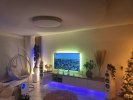BarrryBarrry
Member
- Joined
- Dec 11, 2023
- Messages
- 9
- Likes
- 0
Hi people!
I'm getting slowly my way in audioland. Had some upgrades an finally got that sound I like (for now). Setup is a Tv, optical, Nuprime dac-9, Nuprime AMG STA, RU connected copper cables, B&W 683 S2, old Rel quake sub and a big diy acoustic panel on the sealing.
I would like to experiment with the sound and I'm interested in adding a tube buffer in de system. I read that it can compliment a class D amp. There are some chifi cheap options that you can add between the dac and amp. My question is, how could I get a tube buffer that makes a big (as possible) difference to the sound and I can put on and off easy and preferable I would like to be able to have some tone control.
What I would prefer to achieve les harsh sound, warmer voices and air. Budget under €200,-
Thank you
I'm getting slowly my way in audioland. Had some upgrades an finally got that sound I like (for now). Setup is a Tv, optical, Nuprime dac-9, Nuprime AMG STA, RU connected copper cables, B&W 683 S2, old Rel quake sub and a big diy acoustic panel on the sealing.
I would like to experiment with the sound and I'm interested in adding a tube buffer in de system. I read that it can compliment a class D amp. There are some chifi cheap options that you can add between the dac and amp. My question is, how could I get a tube buffer that makes a big (as possible) difference to the sound and I can put on and off easy and preferable I would like to be able to have some tone control.
What I would prefer to achieve les harsh sound, warmer voices and air. Budget under €200,-
Thank you
Attachments
Last edited:

